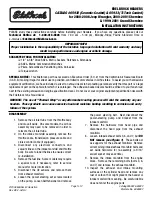
Automatic door-lock/unlock
CX-9 /2007 Version 1.0
Page 3
2.
The Circuit explanation (Detailed diagram in Appendix-A)
Power-up reset
As soon as 12V power is supplied, independent of parking brake-switch, relay-C is activated. Contact-A is
moving from Normally Closed (NC) to Normally Opened (NO) and is preventing that a door-lock signal
can be passed on. Capacitor C1 is getting charged and at a certain moment Relay-C will drop off.
Contact-A is returning to NC and a door-lock signal to be passed on (depending on Pulse relay).
Activator
The parking brake-switch is the causing the activation. When pressed (e.g. parking brake is on) the
parking brake-switch will connect to ground. Through D1, relay-A is activated with a little delay caused
by R1 & C3. This is necessary to give relay-C at power-on/off just a little head start (~10ms) to make sure
Relay-C is activated JUST before relay-A. As relay-A is a double contact relay BOTH contact-C and
contact-D will move from NC to NO at the same time. This condition will stay until the parking brake is
released (e.g. parking brake is off), relay-A will drop off and contact-C and contact-D will return to NC.
A diode over the relay-A is to prevent spikes to the capacitor C3. Don’t be a wise guy and a put a diode
over the relay-B and relay-C; the circuit will not work.
Pulse
When contact-C closes (e.g. relay-A is on because the parking-brake is on), relay-B will activate and close
contact-B, allowing signal for door-lock to be passed on. Capacitor C2 starts charging and at a certain
moment relay-B will drop off. Contact-B is returning to NC, stopping a door-lock signal.
The timing for relay-C (reset) is twice the time for relay-B (Pulse). The current values will give about ~3
seconds reset and ~1.5 seconds pulse.
Step-by-step how it works
1A:
When power is applied first time, relay-C will be activated for ~3 seconds power-on, contact-A is
open and thus NO a door-lock signal can be passed on.
1B:
When the parking brake is pressed (on) at the time power is applied, it will activate relay-A with a
little delay (~10ms) to allow step 1A to start happening JUST a little tiny bit earlier. Relay-B will be
activated, by contact-C. Contact-B will close, however as contact-A is open (see step 1A) no door-lock
signal is passed on. Capacitor C2 is getting charge and relay-B will drop off after 1.5 second and then
relay-C will drop-off, because capacitor C1 is now charged.
1C:
When the parking brake is now released (off), relay-A will drop off after a tiny small delay and
contact-C and contact-D will return to NC, connecting to relay-B to ground.




































